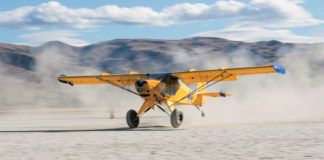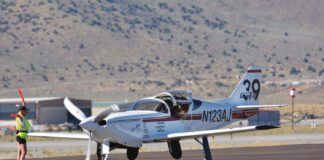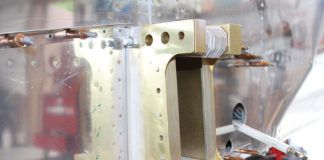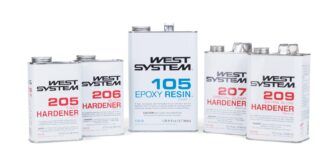Some say ours is now a world of quickbuild kits, builder assistance and high expectations—at least your kit will be complete and, assuming no major crises, you’ll someday get your airplane flying. Within that mindset, it’s easy to forget that somebody outside the factory must go first. Being at the head of the line often presents all the challenges of boldly going where no builder has gone before—regardless of the degree of factory completion. Further, the first builder may also opt to incorporate any number of possible options and custom touches that make homebuilding so attractive. Variable heaped on top of variable.
This may give you a snapshot of what Robert Simon faced when he took delivery of the kit from which he built the first Lancair ES-P to fly. The ES-P itself represents a true first because it’s a hybrid. Employing the cabin design and structure of the pressurized, retractable Lancair IV-P, the ES-P provides a comfortable 6000-foot cabin altitude while flying well into O2 territory. But with the much larger wing and fixed gear of the ES, the kit eschews the weight, complexity, build time and cost of a retractable-gear airplane and provides runway performance and handling useful to typical pilots. Put simply, the ES’s larger wing provides lower approach and landing speeds, as well as permitting comfortable use on shorter runways than is the case with the IV-P.
In the Manual Mode
Even though the ES-P is familiar to builders from the ES and the IV-P standpoints, this new configuration was, when Simon began building, known to no one. He found himself in that position as he started up the learning curve toward flying the first customer-built ES-P after a scant 16 months of work. Simon worked with the assembly manuals for two different Lancairs—one for the company’s pressurized IV-P, the other for its fixed-gear ES. That’s daunting enough, but he also deviated significantly from Lancair’s base design to incorporate some changes that required factory support to accomplish—these are true “Don’t try this at home” building issues.
Simon’s motivation for building the first ES-P wasn’t self flagellation, though that seems the obvious answer. No, it had to do with transportation requirements. Simply put, he needed more airplane than he had from his first building project, the GlaStar he still owns. When a daughter moved to the Phoenix area, Simon’s wife asked about flying time to make the trip from Columbus, Ohio, in their 140-knot GlaStar.
“When I gave her the answer, she basically said, ‘No way…we need a faster way,’ and I told her the only way to get dramatically faster was to build another plane. She said, ‘Build another airplane, then.’” (Most builders would want to know if she had unmarried sisters at this point.) “So I started shopping, researching what was out there,” Simon said.
He wanted twice the speed—or as close to double as he could get to halving the GlaStar’s time—twice the GlaStar’s range to possibly make that Columbus-Phoenix flight nonstop, and double the GlaStar’s seating to accommodate friends, family or some of his four dogs. His mission profile pointed toward the Lancair IV-P. “It had everything to fit my needs—but I didn’t want the hassle of the folding wheels.” He kept looking.
Lancair must have channeled his thinking. After Simon decided to pass on the IV-P, Lancair unveiled a new option: the ES-P. Powered by a Continental TSIO-550C engine, the ES-P benefits from its ability to make its full rated 350 horsepower at 2600 rpm well into the flight levels—with cruise power as high as FL280.
Horsepower + Altitude = Good
Turbocharging does predictable things for speed. According to Lancair’s figures, if you take the ES-P to 24,000 feet (FL240) and wring the big Continental’s neck, you’ll see 293 mph (255 knots) true airspeed. At 17,500 feet—for you VFR pilots—the ES-P is said to true 270 mph/235 knots. If you’re going to run these speeds, expect to put between 19 and 20 gph through the pipe. Lancair says “between 17.5 and 19 gph,” figures that don’t quite jibe with 75% power at a reasonable rich-of-peak fuel specific. However, the TSIO-550 is capable of surprisingly good fuel specifics when run lean of peak; a fuel burn of less than 18 gph is possible at 75% power at the ideal mixture setting. (The TSIO-550-C has a lower compression ratio than, say, the turbonormalized version in the turbo Cirrus, so its fuel specifics aren’t quite as good.)
At full trot, Simon’s ES-P gives him close to what he wanted in speed. With a total of 121 gallons of fuel good for a range of more than 1300 nautical miles, plus reserves, Simon also found the reach—and four seats plus luggage space qualified as twice the space.
Hauling Habits Drive Model Mods
Arguably the most significant of Simon’s customizations evolved so he could use the unpressurized luggage space to fly some of his family’s beloved greyhounds. “I needed the luggage area pressurized,” he says. “That entailed some work.” Some work? How about coordinating with the factory to re-engineer and reinforce the fuselage structure aft of the original intersection with the original pressure bulkhead; designing, fabricating and installing a new aft pressure bulkhead; and relocating and re-plumbing the pressurization system. Do we need to repeat the “Don’t try this at home” caution from earlier?
Making the luggage space pressurized also meant eliminating the luggage door—fine with Simon, though that leaves the cabin door as the only means of loading. With a larger pressure vessel to cool, Simon doubled up on the chillers for the air conditioner—one aft, the other under the instrument panel. Relocating the pressure-bulkhead allowed Simon to add an auxiliary fuel tank—in reality a Plan B action. Originally, he wanted to add fuel capacity to the wings…that was Plan A. “The wings got closed up without opening up more bays for fuel,” he explained. (For those unfamiliar with the ES wing, it is made up of several bays between the molded ribs. Enterprising builders often close out more of these bays than the factory originally specified and seal them for fuel.) So he built a 16-gallon auxiliary tank under the luggage floor and plumbed the filler to the fuselage surface aft of that space.
Double, Double
The finished plane, N301ES, reflects Simon’s desire for the maximum possible redundancy. He doubled on dual pitot/static systems—completely separate pitot tubes, static vents and plumbing; alternators and batteries; electrical buses and regulators; intercoolers to go with the dual turbochargers, and a LightSpeed electronic ignition to backstop the traditional magneto. And there’s more. “Everywhere I could, I put in two—two transponders, two PFDs, pitot/static, electrical—two of everything everywhere possible,” he said.
With two independent GPS systems, dual navs and dual coms, you might think that N301ES would resemble a flying antenna farm, but Simon’s custom touches cut to a minimum the number of antennas seeing air. For example, behind access panels for the leading edge of the fiberglass vertical stabilizer sit two shelves he fabricated to hold the GPS antennas. In fact, with a few exceptions, the plane’s antennas live inside the airframe. To provide a healthy ground plane, Simon employed a metalized carbon cloth bonded directly to the skin and painted over.
No question adding pressurization to the ES adds weight, as do Simon’s myriad modifications and penchant for systems redundancy. As a result, his ES-P came in at an empty weight of 2574 pounds—ironically, not dramatically lighter than most Lancair IV-Ps. (For the trade of the retracting gear, Simon paid back with the extra wing area, which extracts a weight penalty all by itself.) At the 3890-pound gross weight he set—up from the nominal 3550 set by Lancair—N301ES can carry four, up to about 100 pounds of luggage and partial fuel, at least enough to travel 1000 n.m. at reasonable power settings.
Saddling Up
A pilot unaware that the ES-P provides a pressurized cabin should notice a few different things when settling in. Pressurization-system control and a cabin altimeter are there to manage and monitor pressurization. There are two door-lock levers and a small toggle switch adjacent to the window of the top-hinged door. After securing both latches, flipping that switch engages a pump to inflate a door seal. Trying to latch the door with an inflated seal is a non-starter.
With the batteries engaged and the magneto rocker switches closed, my introduction pilot, David McRae, coached me on the standard drill for firing up this Continental—completely conventional. Thanks to a recent positioning flight, temps quickly reached the green and we turned onto Runway 35 at Wichita’s Westport Airport (71K). Smoothly, slowly advancing the throttle avoided excess boost from the accelerating turbochargers, yet the engine still spooled quickly to its 2600-rpm redline, and we were rolling.
With slight differential braking to hold the centerline, the ES-P quickly accelerated to where rudder took over—about 40 knots—and in about 12 seconds we reached the 70-knot rotation speed McRae set. At 75 knots N301ES lifted smartly off the runway, using only 1600 of the 2300 feet available to clear wires 50 feet north of the runway end.
While Wichita Approach vectored us toward our practice area, the TAS600 added its own aural and visual traffic alerts to the call-outs from our departure controller. Level at 3000 feet msl and vectored eastbound, the ES-P quickly imprinted strong impressions on me. The ES-P can over-rotate if not pitched down after liftoff, and the side sticks seemed a little resistant or stiff, an impression matching my reaction to other side-stick designs. At least, that’s how it struck me at the time. Nonetheless, control forces didn’t seem heavy so much as firm. This came through with further maneuvering.
Starting a series of standard-rate turns, for example, required merely firm wrist pressure in the desired direction to roll the ES-P nicely. To turn quickly or tightly required more wrist pressure and discernible movement of the stick.
Cruising along at 4000 feet msl at moderate power and trimmed for about 165 knots indicated, N301ES showed the flip side of its resistance to finger-tip maneuvering; stability seemed to strengthen with speed. With my left hand resting lightly on the side stick, the ES-P tracked straight and true, needing only slight nudges on the control to counter slight wanderings induced by the turbulence of Kansas winds over the Flint Hills east of Wichita.
Time constraints kept us from sampling the ES-P up at the altitudes where Lancair designed it to shine. [The last 310-hp Lancair ES we tested ran 190 KTAS at 8000 feet msl. Assuming approximately the same drag profile for the ES-P, a rough estimate of its potential at 17,500 feet is 212 KTAS, and 235 KTAS at FL250.—Ed.]
Maneuvering and slowing gave me a better feel for the ES-P’s response as we neared Augusta Municipal (3AU) to try my first landings. It seemed prudent to work on landings on Augusta’s 4200-foot runway rather than Westport’s 2500 feet.
The decision also gave me an opportunity to sample the RDD Enterprises/Precise Flight speed brakes Simon installed. A smallish toggle switch mounted low on the central panel activated the electrically driven panels, and they pivoted up smoothly from the top of the wing.
Experience with Precise Flight’s speed brakes on other fast pistons conditioned me to expect the rapid descent—1800 fpm in this case—that the brakes produce. Previous exposure also conditioned me to expect some indication beyond the VSI, but there was none of the rumble or vibration of past encounters.
After reaching pattern altitude of 2200 feet msl, reducing power and pitching up, N301ES slowed nicely, taking about a minute to drop to 100 knots from 165. I slowed further to 90 knots on entering downwind, maintaining power to hold altitude until rolling out on final, then held 90 knots, kept the nose down and managed glideslope with power.
In truth, though, my mom won’t get any letters about that first approach. Yeah, it worked as advertised, but with about 1000 feet of runway behind—way more than I like—after a firm, mains-first touchdown. Despite the long touchdown, the ES-P’s powerful brakes slowed us enough that I could make the midfield turnoff.
Taxiing to Runway 18 gave me more time to practice my skills steering with differential braking. My next takeoff was more centered with less wandering. Repeating the takeoff technique brought N301ES off the runway just as 75 rolled by on the airspeed tape. The instant the ES-P left the ground I eased off the stick pressure slightly and avoided a more abrupt pitch-up, setting N301ES up for a 100-knot cruise climb that yielded about 1700 fpm and a good view over the cowl.
In Retrospect
Later, when filling in my notes from the flight, something I’d missed in the heat of the airport work occurred to me. I’d forgotten completely about those “firm” stick pressures that stood out earlier. Although there’s little question that the pressurization on Simon’s airplane has added heft, which reduces climb performance and slows reflexes, the benefits outweigh the disadvantages for a cross-country traveling machine.
Want one yourself? First, you can thank Robert Simon for figuring out some of the tougher issues in mating, in effect, a Lancair IV-P fuselage with ES running gear. Then start your budget. Simon confesses to having around $400,000 in his project. Lancair estimates a completed range of $350,000 to $550,000, which, we’re somewhat astounded to say, sounds about right. The base kit—indeed, the only kit—is a quickbuild at $129,900. The top engine choice, a Platinum version of the TSIO-550, runs a breathtaking $97,000 all by itself. Add prop, interior, avionics and paint—and those “could buy a house” figures come into focus. We give credit to Lancair for posting prices of the big items and many of the accessories—some of which you really want in this kind of airplane (like air conditioning)—on its web site.
High performance is expensive, and Simon is the first to suggest that time is like gold. For the right builder, who truly needs the high-altitude performance that comes with turbocharging, and who wants the comfort that comes with pressurization but isn’t willing to limit himself to long, smooth runways—a requirement that Lancair IV-P owners know well—the ES-P is an excellent choice.
For more information, call 541/923-2244, or visit http://www.lancair.com/.




